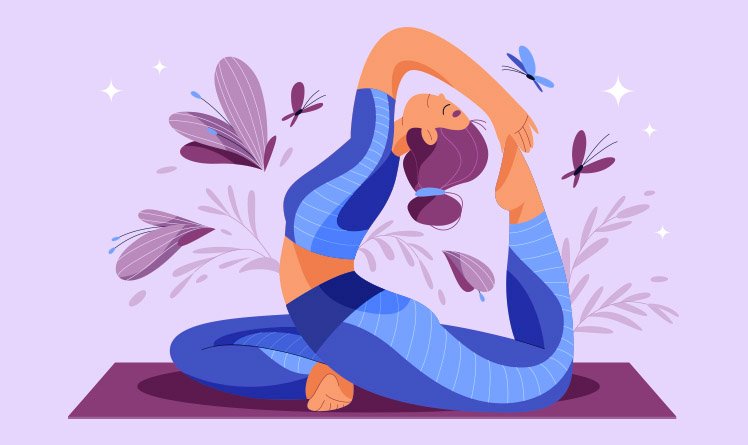How to practice yoga at home and improve your daily well-being with mindfulness and NLP

|
Getting your Trinity Audio player ready...
|
First of all, let's agree on one thing: practice yoga It's not just about pretty poses on Instagram. In other words, it's about creating an internal space where body and mind align, and where the day begins—or ends—with more lightness, focus, and purpose. At Mindset Reprogramado, we believe that yoga practice can go far beyond the physical when combined with techniques like mindfulness and Neuro-Linguistic Programming (NLP). In this guide, you will learn how to practice yoga at home simply, consistently, and most importantly, in a way that truly improves your daily well-being.
What is yoga and why it goes beyond the physical
Yoga is an ancient practice that originated in India and integrates body postures (asanas), breathing exercises (pranayamas), meditation and ethical principles. Thus, it is much more than stretching or physical exercise, it is a philosophy of life that seeks union (yuj, in Sanskrit) between body, mind and spirit.
So, when you practice yoga, you're not just strengthening muscles or increasing flexibility. Above all, you're working on your breath control, the ability to concentrate and mental clarity. This is where he connects deeply with the mindfulness and NLP: both expand your awareness, help break limiting mental patterns and enhance the benefits of the practice.
“Yoga is a practice that combines physical postures, conscious breathing, and meditation to integrate body, mind, and emotions, promoting balance and well-being.”
Why practicing yoga at home can be so powerful
Practicing yoga at home offers unique advantages. After all, you can choose your own schedule, create a peaceful environment, and adapt the intensity to your needs. In other words, with discipline, the practice becomes a self-care ritual that nourishes body and mind daily.
Furthermore, practicing at home eliminates barriers such as travel, the cost of in-person classes, and even the insecurity of just starting out. In other words, for those looking to daily well-being, is an affordable and highly effective path.
Preparing the environment for practice
Before learning how to practice yoga In a structured way, it's essential to prepare your space. So, here are some quick tips:
- Choose a quiet place: Initially, it could be a corner of the bedroom or living room, but a place that conveys tranquility.
- Use a yoga mat: It prevents slipping and ensures comfortable postures.
- Soft lighting: Natural light is ideal, but a lamp with warm light also creates a cozy atmosphere.
- Extra elements: Candles, incense, or soft background music can help with immersion, but are optional.
Tip: If possible, always have your space ready. This will greatly reduce resistance to starting your practice.
The role of conscious breathing in yoga
First of all, at the basis of all yoga practice is the pranayama, or breath control. Above all, conscious breathing increases oxygenation, calms the nervous system, and prepares the body for postures.
Therefore, a simple technique for beginners is diaphragmatic breathing. Here's how:
- Sit or lie down comfortably.
- Inhale through your nose, expanding your abdomen.
- Exhale slowly, emptying your lungs completely.
- Repeat for 3 to 5 minutes before starting the practice.
“Conscious breathing in yoga is called pranayama and aims to balance body and mind, increasing vital energy and reducing stress.”
Simple yoga sequence for beginners at home
If you're just starting out, it's important to have a structured yet accessible sequence. In this sense, the proposal here is a flow of about 20 to 25 minutes This sequence can be done daily, adapted to your level of flexibility and endurance. This sequence aims to warm up the body, improve posture, increase mobility, calm the mind, and create a solid foundation for further practice.
Initial tip: Before you begin, prepare your space (mat, comfortable clothing, and a calm environment) and set an intention for the practice—it could be "relax," "gain focus," or "increase my energy." This connects body and mind and gives meaning to the session.
1. Grounding Breathing (Pranayama) – 2 minutes
Sit in a comfortable position, close your eyes, and place your hands on your knees. Then, inhale deeply through your nose, expanding your abdomen, and exhale slowly.
Objective: activate diaphragmatic breathing, reduce anxiety and prepare the body for movements.
2. Mountain Pose (Tadasana) – 1 minute
First, stand with your feet parallel, your spine straight, and your shoulders relaxed. Then, imagine a string pulling the top of your head upward. Then, breathe deeply, feeling yourself standing as steady as a mountain.
Objective: improve posture, align the spine and create presence.
3. Sun Salutation (Surya Namaskar) – 5 minutes
Fluid sequence that combines breath and movement:
- Tadasana (standing) – inhale
- Hands together on the chest – exhale
- Raise your arms and lean back slightly – inhale
- Forward Bend (Uttanasana) – exhale
- Right foot back, knee on the floor – inhale
- Plank – exhale
- Chaturanga (push-up with arms close to the body) – inhale
- Dog looking up (Urdhva Mukha Svanasana) – inhale
- Downward Facing Dog (Adho Mukha Svanasana) – exhale
- Return from the opposite side and return to the beginning.
Objective: warm up the body, improve circulation, strengthen muscles and increase flexibility.
4. Downward Facing Dog (Adho Mukha Svanasana) – 1 minute
From the plank position, lift your hips, forming an inverted "V" with your body. Keep your hands and feet firmly on the floor.
Objective: stretch the posterior chain (calves, hamstrings, spine) and strengthen arms and shoulders.
5. Warrior II Stance (Virabhadrasana II) – 2 minutes (1 min each side)
With your legs apart, bend your front knee 90 degrees and keep the other knee extended. Now, open your arms in line with your shoulders, looking over your front hand.
Objective: strengthen legs and hips, increase stability and mental focus.
6. Child's Pose (Balasana) – 2 minutes
Kneel down, sit back on your heels, and lean forward until your forehead touches the floor, arms extended or at your sides.
Objective: relax the spine, calm the nervous system and integrate the practice.
7. Seated Twist (Ardha Matsyendrasana) – 2 minutes (1 min each side)
While sitting, cross one leg over the other and rotate your torso towards the knee that is on top.
Objective: stimulate internal organs, improve digestion and spinal mobility.
8. Bridge Pose (Setu Bandhasana) – 2 minutes
Lying on your back, bend your knees and keep your feet flat on the floor. Then, raise your hips, keeping your shoulders and arms supported.
Objective: strengthen glutes and lower back, open the chest and improve breathing.
9. Final Relaxation (Savasana) – 5 minutes
Lie on your back, arms at your sides, and eyes closed. Above all, focus on your breathing and allow your body to relax completely.
Objective: integrate the benefits of practice and promote physical and mental rest.
Tips for maintaining consistency:
- Start slowly: 2 to 3 times a week at first and gradually increase.
- Use guided videos: helps to correct posture and maintain rhythm.
- Listen to your body: Yoga is not about forcing yourself, but about respecting your limits.
- Combine with mindfulness: In each posture, observe your bodily sensations and breathing.
- Apply NLP: mentally associate each posture with a desired emotional state (calm, confidence, energy).
“A simple yoga sequence for beginners might include mindful breathing, Tadasana, Sun Salutation, Downward Facing Dog, Warrior II, Child's Pose, Seated Twist, Bridge, and final relaxation, totaling about 20 to 25 minutes.”
Integrating mindfulness in your yoga practice
THE mindfulness It enhances the quality of your yoga practice because it helps you be fully present in what you're doing. This means feeling each movement, noticing your breath, observing your thoughts without judging them, and redirecting your attention to the present moment.
A simple exercise: during each pose, ask yourself, "What am I feeling right now in my body and mind?" This question is a trigger to get out of autopilot mode and into a state of mindfulness.
How NLP enhances the results of yoga
Neuro-Linguistic Programming can transform your yoga practice into a catalyst for mental and emotional change. Some practical applications:
- Emotional anchors: associate a relaxation posture (such as Savasana) to a calm state of mind to access when you need it in your daily life.
- Resignification: using moments of discomfort in a difficult posture as a metaphor for better handling challenges off the mat.
- Visualization: Before practicing, imagining yourself completing the sequence with energy and well-being increases motivation and consistency.
Overcoming obstacles to practicing at home
Some common challenges:
- Lack of discipline: mark the practice on your calendar as an appointment.
- Reduced space: a rug is enough, even in small apartments.
- Demotivation: start with short sessions and gradually increase.
Benefits of joining yoga, mindfulness and NLP for daily well-being
When you combine all three approaches, you create a positive cycle:
- THE yoga strengthens the body and calms the mind.
- THE mindfulness trains your attention to be in the present.
- THE NLP helps to reprogram mental patterns, replacing limiting beliefs with empowering beliefs.
The result? Greater emotional balance, focus, and energy to face the day with clarity and purpose.
Conclusion
Practicing yoga at home is more than just a physical activity—it's an invitation to reconnect with yourself and create a routine that supports your long-term well-being. Therefore, combining yoga with mindfulness and NLP, makes you transform your mat into a laboratory of self-knowledge and mental reprogramming.
So start today, even if it's just for a few minutes, and allow yourself to feel the difference in your body and mind.
FAQ – Frequently asked questions about practicing yoga at home
1. What is the best time to practice yoga at home?
Ideally, practice in the morning to energize the day or in the evening to relax, but the best time is whenever you can maintain it consistently.
2. Do I need experience to start?
No. Beginner sequences are simple and adaptable to any level of flexibility or fitness.
3. Can I practice yoga every day?
Yes, as long as you respect your limits and vary the intensity.
4. Does yoga help you lose weight?
Yoga is not a workout focused on weight loss, but it improves metabolism, reduces stress, and can aid weight loss when combined with healthy habits.
5. How to avoid injuries when practicing alone?
Respect your limits, avoid forcing postures, and, if possible, follow videos or instructions from qualified instructors.
If you want your yoga practice to go far beyond the mat and truly transform your life, the next step is to reprogram your mind to eliminate limiting beliefs and patterns that sabotage you.
Get the eBook “Reprogram your Mindset: Identify your blocks and start your transformation” and discover techniques of mindfulness, NLP and positive psychology to increase your focus, emotional balance and daily well-being.
Image: Freepik

Marcel Castilho is an expert in neuromarketing, neuroscience, mindfulness and positive psychology. In addition to being an advertiser, he also has a Master's degree in NLP – Neurolinguistic Programming. As the owner and founder of the communications agency VeroCom and also of the digital agency Vero Contents, he has been studying human behavior for over 30 years.

